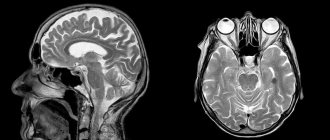Negativism: causes of development in children, adolescents and adults, symptoms and correction of stubbornness
In psychology, negativism means a person’s resistance to any external influence, devoid of rational premises, even contrary to his own well-being.
In a more general sense, this concept denotes a generally negative perception of the world around us, the desire to do everything contrary to requests and expectations.
In pedagogy, the term “negativism” is applied to children who are characterized by an oppositional manner of behavior with people who should be an authority for them (teachers, parents).
General information
In psychology, negativism is a separate term to designate a symptom of unmotivated resistance, characterized by a disorder of will and manifested in catatonic excitement and catatonic stupor - psychopathological syndromes, accompanied by movement disorders of an inorganic nature
It is important to distinguish children from stubbornness, since it has its own reasons, and the origin of negativism reactions is unconscious. They can manifest themselves at a communicative, behavioral or deep level (do not give external manifestations)
Typically, negativism comes down to unmotivated resistance to any demands/requests to move, speak, or follow any instructions, as well as the desire to do things contrary. It causes disruption of communication, learning and, in general, adaptation in this world.
According to Kretschmer, negativism is a manifestation of the activity of hypobulic mechanisms - a mental state characterized by a reduced desire and urge to activity. Whereas Bleuler believed that unconscious resistance was a sign of autism or personality dissociation.
A child spoils and breaks toys, what should I do?
This question interests a good half of parents. The reasons for this behavior in children are different.
First of all, toys need to be purchased according to the age of your baby, since younger children still have poor control over their strength and can break very fragile toys intended for older children.
In this case, there is no fault of the child - he does not do this on purpose. But in most cases, the child does this on purpose and parents need to understand the reasons for this behavior. It is possible that such behavior carries a “hidden” message from the child to the parents.
Let's look at the most common reasons for this behavior.
The toy is one piece and cannot be taken apart, but I really want to!
In this case, the child is driven by the desire to understand how the toy works: he begins to tear off wheels, stickers, squeeze out glass, etc. etc.
The child tries to take it apart out of curiosity and then put it back together. The solution here may be to buy construction sets.
Now there is a large selection of construction sets, both for girls and boys, for different ages - from the simplest to the most complex.
Child's awkwardness.
There is a category of parents who raise infants without toys at all, believing that children still do not know how to play with them, but only throw them around, as a result of which the rattles break.
The result of this is a delay in the formation of skills in handling objects - motor awkwardness.
As a result, the child’s development is delayed: the development of fine motor skills and perception of the environment.
In this case, only a specialist – a neurologist – can help the child. If this is not done, then the possibility cannot be ruled out that difficulties will arise when learning to write, cut, sculpt, or draw.
From the very first days of life, a child needs to be taught to use rattles and cubes: the more the child picks up objects, the faster his development occurs, both physically and mentally - the faster the baby’s horizons develop.
Internal aggression.
When a child is offended or upset about something, he begins to hit or throw toys around. In such a situation, you need to calm the child down as soon as possible and find out from him the reason for such aggression.
The toy is not liked or causes fear.
Negativism in children, adolescents and adults
Negativism is a state of rejection, rejection, a negative attitude towards the world, towards life, towards a specific person, and is a typical sign of a destructive position. May manifest as a personality trait or situational reaction.
The term is used in psychiatry and psychology. In psychiatry it is described in connection with the development of catatonic stupor and catatonic agitation.
In addition, coupled with other manifestations, it is a sign of schizophrenia, including catatonic.
In psychology, this concept is used as a characteristic of the characteristics of the manifestation of age-related crises. It is most often observed in children three years of age and adolescents. The opposite of this state is: cooperation, support, understanding. The famous psychotherapist S. Freud explained this phenomenon as a variant of primitive psychological defense.
The concept of negativism has some similarities with the concept of nonconformism (disagreement), which means the active rejection of generally accepted norms, established order, values, traditions, laws.
The opposite state is conformism, in which a person is guided by the attitude of “being like everyone else.”
In everyday life, nonconformists usually experience pressure and aggressive behavior from conformists who represent the “silent majority.”
From the point of view of science, both conformism and non-conformism are elements of childish, immature behavior. Mature behavior is characterized by independence. More adult manifestations of behavior are love and care, when a person evaluates his freedom not as the fact that one can not do something, but, on the contrary, one can do something worthy.
Negativism can manifest itself in the perception of life, when a person sees complete negativity in life. This mood is called a negative worldview - when a person perceives the world in dark and gloomy colors, he notices only the bad in everything.
Signs
A person can independently determine the presence of this condition by the presence of the following symptoms:
- thoughts about the imperfection of the world;
- tendency to worry;
- hostile attitude towards people with a positive worldview;
- ingratitude;
- the habit of living through a problem instead of looking for a way to solve it;
- motivation through negative information;
- focusing on the negative.
Research by psychologists has made it possible to establish several factors on which negative motivation is based, among them:
- fear of running into trouble;
- guilt;
- fear of losing what you have;
- dissatisfaction with your results;
- lack of personal life;
- the desire to prove something to others.
When communicating with a person who shows signs of this condition, you should be careful and not openly point out to them the presence of this pathology, as they may display a defensive reaction, which will further strengthen their negative perception.
At the same time, each person is able to independently analyze his condition and not allow himself to “fall into negativism.”
Types of negativism
Negative perception can manifest itself in both active and passive form. Active negativism is characterized by open rejection of requests; such people do the opposite, no matter what they are asked for. It is typical for children three years old. Speech negativism occurs quite often at this time.
Little stubborn people refuse to fulfill any requests from adults and do the opposite. In adults, this type of pathology manifests itself in schizophrenia, so patients are asked to turn their face, they turn in the opposite direction.
At the same time, negativism must be distinguished from stubbornness, since stubbornness has certain reasons, and negativism is unmotivated resistance.
Passive negativism is characterized by complete disregard for demands and requests. It is usually present in the catatonic form of schizophrenia. When trying to change the position of the patient's body, he encounters strong resistance, which arises as a result of increased muscle tone.
In addition, behavioral, communicative and deep negativism are distinguished. Behavioral is characterized by refusal to fulfill requests or acting contrary. Communicative or superficial is manifested in the outward manifestation of rejection of someone's position, but when it comes to a specific matter, such people are quite constructive, sociable and positive.
Deep negativism is an internal rejection of demands without external manifestations, which is characterized by the fact that no matter how a person behaves externally, he has a negative prejudice inside
Negativism and age
Childhood negativism first appears in children three years old. It was during this period that one of the age-related crises occurred, which was called “I myself.” Children of three years old begin to fight for their independence for the first time; they strive to prove their maturation.
The age of three is characterized by such signs as whims and active rejection of parental help. Children often express objections to any proposals. In three-year-old children, a manifestation of negativism is the desire for revenge.
Gradually, with the correct reaction from adults, children's negativism in a preschooler disappears.
A frequent manifestation of this condition in a preschooler is mutism - speech negativism, which is characterized by refusal of verbal communication.
In this case, you should pay attention to the child’s development in order to exclude the presence of serious health problems, both mental and physical. Speech negativism is a frequent manifestation of the three-year crisis.
Rarely, but it is possible for a similar condition to manifest itself at 7 years of age.
Children's negativism may indicate the presence of mental pathology or personality problems. Prolonged negativism in a preschooler requires correction and special attention from adults. Reactions of protest behavior are characteristic of adolescence.
It is at this time that negativism in children becomes the cause of frequent conflicts at school and at home. Teenage negativism has a brighter color and manifests itself at the age of 15-16 years. Gradually, as they grow older, these manifestations disappear with the competent approach of parents. In some cases, behavior correction is required.
For this purpose, parents of a rebellious child can seek help from a psychologist.
Currently, experts note a shift in the boundaries of age-related crises among younger generations.
In this regard, the phenomena of negativism become typical for young people aged 20-22 years, which undoubtedly leaves an imprint on their socialization.
Negativism can manifest itself in later life, and in older people during periods of exacerbation of personal failures. In addition, it occurs in dementia and progressive paralysis.
Source: https://indepress.ru/shizofreniya/negativizm.html
Symptoms
Negativism usually manifests itself both in behavior, habits, and in the way of thinking, in ideals, creative expressions, handwriting and even in appearance. In this case, the patient experiences:
- negative emotional reactions;
- demonstrativeness (tattoos, aggressive jewelry and hairstyles, masculinity);
- suicidal thoughts;
- low background mood, manifested in the form of gloom, depression, gloominess and isolation;
- asociality;
- aggressiveness;
- increased level of anxiety;
- severe disorganization;
- increased muscle tone;
- catatonic excitement - echosymptoms, paramimia, periodic stereotypies, pretentious movements (for example, the patient takes food that is located on the right with his left hand, holds it behind his back, etc.).
Classification
According to the form, active, passive, paradoxical, speech, neurotic and psychotic negativism are distinguished:
- The active form of negativism is protest behavior - the emergence of a reaction of resistance to any demands, as well as the performance of any actions contrary to those required.
- Passive negativism is ignoring or completely refusing to fulfill any requests or demands, but if someone tries to force the patient to do what is necessary, then the response will most likely be a reaction of active negativism - resistance against the background of increased muscle tone.
- Paradoxical manifestations of negativity come down to the performance of actions and the development of reactions in patients that are diametrically opposed to the requirements. For example, if the patient is asked to turn his face, he turns his back, if you need to give a hand, he hides it, etc. In principle, the paradoxical form can be considered as a type of active negativism.
- Verbal negativism is essentially the patient's refusal to answer any of the questions in a test or conversation. The closest to this type of reaction is considered to be mutism, in which there is a lack of verbal contact, and people understand the speech of others and are able to speak, but during communication they do not reproduce either response or spontaneous speech.
- Neurotic negativism is characterized by the patient’s refusal to perform actions in situations that cause him anxiety and fear. For example, it is observed with selective mutism in children.
- Psychotic negativism causes resistance to urges associated with psychotic symptoms, including delusions, hallucinations, catatonia, and confusion.
Negativism caused by poor health is most often total in nature and manifests itself not only in behavior, but also in the style of communication and outlook on life. In other cases, unmotivated resistance may be selective and manifest itself in certain conditions or in relation to certain people.
In addition, depending on the origin of the motives, negativism can be external and internal, that is, opposition is caused by external motives or, accordingly, by one’s own internal ones.
The psychological essence of stubbornness and negativism in children 2653
... Negativism and stubbornness are similar in their external manifestations, but, nevertheless, they have many differences. For further analysis, it is necessary to clarify the meaning of the concept of “negativism”.
Negativism (English negativism; from Latin negatio - denial) is considered in psychology as a subject’s resistance to the influences exerted on him without any reasonable basis. The Psychological Dictionary [19] defines negativism as acts of individual behavior, mostly unmotivated, which manifest themselves in oppositional actions and reactions to the demands and expectations of other subjects. The psychological basis of negativism is the individual’s ego-set to deny certain concepts, rituals, communications, and expectations of a particular social group.
The “Explanatory Dictionary of Analytical Psychology” [27] defines negativism (Latin negativus - negative) as a negative attitude towards the influences of the external environment, fencing off from external impressions and counteracting impulses coming from outside.
In the “Psychological Dictionary” [20] and the “Modern Psychological Dictionary” [24], children's negativism is understood as a form of child’s protest against a really existing (or perceived as real) unfavorable attitude towards him on the part of peers or adults. Negativism can manifest itself in different ways: in increased rudeness, stubbornness, isolation, and alienation.
In the “Dictionary of a Practical Psychologist” [23], negativism is considered as unmotivated behavior of a subject, manifested in actions that are deliberately contrary to the requirements and expectations of other individuals or social groups. Here, children's negativism is understood as a form of communication of a child in which he tries to defend the rights of his personality by counteracting the demands of others, and in this case it can manifest itself in the form of stubbornness, rudeness, and isolation.
Outstanding Russian psychologists have studied negativism. In particular, L. S. Vygotsky considered negativism to be manifestations in a child’s behavior when he does not want to do something just because one of the adults suggested it, i.e. this is a reaction not to the content of the action, but to the proposal itself adults.
According to V. Kagan, negativism is behavior in which the assumption of another person is rejected by the subject because this assumption does not come from himself.
A number of researchers (A. Golik, A. V. Zaporozhets, V. Mamtseva, V. S. Mukhina, etc.) identify two types of negativism in child behavior:
- active negativism - resistance to the demands and actions of others, the desire to counteract in one’s actions what they demand or ask, the child’s performance of actions opposite to those required;
- passive negativism - lack of reaction to external motivation for a particular action, stubbornness, reluctance to carry out what is proposed by an adult.
For further analysis, it is also necessary to clarify the meaning of the concept of “stubbornness”. The “Psychological Dictionary” [19] defines stubbornness as a characteristic of behavior, and in stable forms - as a character trait that acts as a defect in the sphere of strong-willed individuality, expressed in the desire to continuously act in one’s own way, contrary to reasonable arguments, requests, advice or instructions other people.
In the “Modern Psychological Dictionary” [24], stubbornness (stubbornness) is interpreted as a form of behavior caused by the motive of self-affirmation. “The Dictionary of a Practical Psychologist” [23] considers stubbornness as behavior characterized by an individual’s active rejection of the demands of other people addressed to him. In this case, behavior moves from the objective plane to the interpersonal one and receives support from the motives of self-affirmation. ...
Manifestations of negativism
There are two types of negativism:
- passive negativism – ignoring requests and demands;
- active negativism - a person loudly protests and does the opposite.
Negativism has age-related characteristics. It is mainly characteristic of children in crisis periods: three years old, adolescence. This phenomenon is often observed in elderly (old) people also during periods of age-related or professional (creative) crisis. Negativism worsens during periods of personal failure or in stressful situations.
However, a situation is often observed in which negativism is not an age-related, but most likely a personal trait. People with negativism behave in protest, regardless of the situation and age.
If negativism is associated with poor health or an unimportant mood, then it manifests itself in everything at once: in behavior, communication style, outlook on life. Sometimes negativism is associated with a person’s upbringing, so often negative words are at odds with deeds. Spouses can swear and make trouble, but in case of problems they take care of each other. Some parents also often behave towards their children. There are also opposite manifestations. Polite, pleasant people at their core may turn out to be misanthropes with antisocial attitudes.
Negativism can manifest itself in relation to certain people, or it can be directed at the whole world. A person may feel that his exclusivity is being suppressed in society. A negative person tries to do things differently from what others do or what others expect from him.
It is difficult for a person with negativism to live on his own. But it’s even more difficult to live next to him. Doing business with a negative person is very difficult or almost impossible. Such people tend to have a negative worldview. They tend to see the negative (a catch, a setup) in all details. A person expects mistakes, not successes, from his activities; problems, not opportunities; disadvantages, not advantages.
The interesting thing is that negative people tend to be friends with each other. It is convenient for them to speak negatively about life, to “throw mud” at the people around them. Such people are not at all surprised that people treat them badly, since they themselves also treat others. Naturally, they do not expect good from people and the world, since they themselves do not wish good to those around them.
Deep negativism is very difficult to recognize. It is difficult to notice a hateful attitude towards society in a seemingly positive person. Such people do not trust others, constantly see intent and sabotage, provoking other people to negative actions.
Reasons for negativism
Negativism can be caused by:
- genetic conditioning;
- hormonal surge during periods of crisis;
- features of upbringing;
- cultural environment.
It is worth saying that negativism is often a feature of mentality. Many people tend to notice flaws first. A typical situation might be that people tend to swear rather than talk.
Negativism may not be present in a person initially. It can be caused by certain circumstances. Psychological reasons may be:
- helplessness in solving the problem, lack of skills and knowledge;
- self-assertion or struggle for power;
- desire to attract attention;
- revenge, hostility.
Sometimes negativity can have psychiatric causes.
Fighting negativism
The difficulty in combating negativism is that a person cannot be directly pointed out about its manifestations. This is dangerous, since people with negativism react aggressively to any activity in their direction. The fight against other people's negativism is a complex and thankless phenomenon. Only a group of people with a creative approach to life can do it.
Close people of a negative person may simply not notice manifestations of negativism, surrounding their loved one with warmth and attention. True, this requires enormous patience and true love.
If you observe manifestations of negativism in yourself, then you need to constantly monitor your own behavior and thoughts.
Developing a positive attitude towards the environment is quite possible. It only takes a few steps:
- Step 1: take off the victim position: don’t whine, don’t complain, don’t feel sorry for yourself.
- Step 2: take on the role of the author: the ability to build your life.
- Step 3: learn to thank the people around you and life in general.
Negativism is an unpleasant phenomenon, but it can be corrected if there are close positive people nearby.
Cause and effect
Such situations in psychology are considered difficult, but not critical. Timely professional techniques will help identify, eliminate and prevent negative trends in the subject’s behavior.
At the same time, you should not think that negativism is a trait characteristic only of children. Negativism often manifests itself in adolescents, adults and even older people. The reasons for the manifestation of negative attitudes in response to external stimuli can be changes in the social life of an individual, psychological trauma, stressful situations and periods of crisis.
To identify formed negative attitudes and prevent their development in the future, a psychological diagnosis of a potential patient should be carried out. Next comes work to eliminate or mitigate the subject’s negative manifestations. First, the original problem that provoked the development of a negative attitude is eradicated.
In addition, pressure on the individual is eliminated so that he can “unblock” and assess the real situation. Adults will be helped by the technique of self-knowledge, when, while working with a psychologist, a person is immersed in his own memories and can find the reason for his dissatisfaction in order to eliminate the consequences.
How to become cheerful with behavior modification technology 7Spsy
The fight against pronounced negativism is a difficult path, on which you will first have to admit to yourself the existing problem and understand the reasons for its occurrence. Think about what exactly pushes you into the abyss of pessimism - financial difficulties, failures in love, difficult relationships with your husband/wife? For the most part, the depth of existing problems depends on the exact mindset with which a person approaches their solution.
In the fight against signs of negativism, psychologists advise changing your attitude towards the world around you. The following recommendations will help:
Start small - in any situation that unbalances you, try to find at least one positive moment. Over time, this will become a habit, and you will no longer consider every problem hopeless.
Negativists can be very rude, which turns people off
It is important to learn to conduct a “normal” dialogue with each interlocutor without sharp criticism and insults - from household members, colleagues, friends
You won't be able to change your communication style quickly. Start with the simplest thing - if you cannot say anything good, productive or useful to your interlocutor, it is better to remain silent.
Try keeping a diary where you can plan pleasant things to do. In your daily to-do list, leave time for hobbies and interests that are fun, calming, and relaxing. The more positive moments in your life, the better.
Negativists perceive committed mistakes very keenly. Every problem seems like the “end of the world” to them.
Try to look at problems from a different angle. Give yourself room for error
It is important to understand that failures are natural, they strengthen and motivate
Negativism and stubbornness manifest themselves as character traits or situational reactions to certain external factors. Essentially, it is a learned behavior pattern that encourages a person to see everything through the lens of dark glasses. When you cannot become a self-confident optimist on your own, do not miss the moment when you can still stop the destructive work of negativism.
Completing the training will help you change the established pattern of behavior that develops a negative attitude towards the world. The course is aimed at acquiring positive attitudes. They will help you understand how unproductive pessimism is and give you confidence in solving problems.
- “Big Psychological Dictionary”, 2005, B. Meshcheryakov.
- “Protest activity of the individual: essence, dynamics, transformation”, 2013, A. Sh. Guseinov.
- “Children’s negativism: signs and reasons for its manifestation” (magazine “Scientific Dialogue”, 2013, No. 8), T. P. Kleinikova.
- “Psychology of age-related crises: Textbook”, 2000, K. N. Polivanova.
Forms of behavioral activity
The term "negativism" is often used in pedagogy. It is used in relation to children who are characterized by an oppositional manner of activity in relations with older people and those who should be an authority for them (parents, grandparents, educators, teachers, lecturers).
IN
In psychology, in connection with the concept of negativism, two main forms of behavioral activity of the subject are considered:
1. Active negativism is a form of individual behavior in which he sharply and quite zealously expresses his resistance in response to any attempts at external influence on him. Subtypes of this form of negativism are physiological (a person’s protest is expressed in refusal to eat, unwillingness to do or say something) and paradoxical (intentional desire to do something the opposite) manifestations.
We recommend: What is conflict?
2. Passive negativism is a form of behavior expressed in the individual’s absolute ignoring of requests or demands. In a child in everyday life, this form manifests itself in the form of a refusal to do what was asked, even if the denial goes against his own desires. For example, when a child is offered food, but he stubbornly refuses.
The negativism observed in children deserves special attention. This is due to the fact that the child often uses this form of resistance, opposing it to an imaginary or actually existing negative attitude towards him on the part of adults. In such situations, negative attitudes become permanent and manifest themselves in the form of whims, aggression, isolation, rudeness, etc.
The reasons for the negativism manifested in children include, first of all, dissatisfaction with certain of their needs and desires. Expressing his need for approval or communication and not receiving a response, the child becomes immersed in his experiences. As a result, psychological irritation begins to develop, against the background of which negativism manifests itself.
We recommend: Rationalization: a method of psychological protection
As the child grows up, he will become aware of the nature of his experiences, and this, in turn, will allow negative emotions to manifest themselves much more often. Prolonged blocking and ignoring of a child's needs by adults and parents can lead to denial becoming a permanent feature of his character.
Related concepts
Negativism is one of the trio of manifestations of a child’s complex of protest behavior.
The second component is stubbornness, which can be considered a form of negativism, with the only amendment that stubbornness in any matter has its own specific reasons, while negativism is resistance that is not motivated by anything. What unites these phenomena is that both arise on the basis of purely subjective human sensations.
One of the closest phenomena to negativism (as a psychiatric term) is mutism. This is a condition in which a person avoids all communication, both through speech and gestures. But, unlike negativism, mutism is mainly the result of a strong shock.
The third component is obstinacy, the difference from stubbornness is that it is not directed at a specific person, but in general at the educational system, the development of events, and so on.
General information
In psychology, negativism is a separate term to designate a symptom of unmotivated resistance, characterized by a disorder of will and manifested in catatonic excitement and catatonic stupor - psychopathological syndromes, accompanied by movement disorders of an inorganic nature
It is important to distinguish children from stubbornness, since it has its own reasons, and the origin of negativism reactions is unconscious. They can manifest themselves at a communicative, behavioral or deep level (do not give external manifestations)
Typically, negativism comes down to unmotivated resistance to any demands/requests to move, speak, or follow any instructions, as well as the desire to do things contrary. It causes disruption of communication, learning and, in general, adaptation in this world.
According to Kretschmer, negativism is a manifestation of the activity of hypobulic mechanisms - a mental state characterized by a reduced desire and urge to activity. Whereas Bleuler believed that unconscious resistance was a sign of autism or personality dissociation.
Signs
Parents need to know how the 3-year-old crisis manifests itself in order to distinguish its symptoms from ordinary contextual situations. For example, if a child refuses to go to bed on time, this may be dictated by the fact that he was overexcited before bed, played too many noisy games, or sat in front of the TV for too long. Each case must be considered separately.
Psychologists call the complex of symptoms of a 3-year crisis “seven stars.”
Negativism - “I’m doing it out of spite!”
They give up their own desires that coincide with the demands of their parents. They don’t want to do something just because the initiative comes from an adult. A negative reaction is always targeted and directed not at the content of the request, but at a specific person. For example, a mother calls her child from the street for lunch. Despite the fact that he himself has been hungry for a long time and wants to go home, he refuses to do this just for the sake of confronting his mother.
Obstinacy - “I don’t want to obey!”
Unlike negativism, this manifestation of the crisis is impersonal. It is aimed at the everyday life and daily routine that parents try to accustom their baby to. He refuses to go to bed at the right time or put away his toys.
Stubbornness - “I decided so!”
"Don't want!" and I will not!" without any explanation - the most common signs of a 3-year crisis. Neither persuasion nor threats can overcome them.
Riot (protest) - “I’m tired of everything!”
Similar to previous manifestations of the crisis. However, rebellion is the most terrible of them. Firstly, it includes negativism, obstinacy, and stubbornness. Secondly, it is permanent. The child refuses breakfast or nap every day. Thirdly, it manifests itself most clearly. It comes to uncontrollable outbursts of anger and real hysteria. This is fraught with severe stress and auto-aggression.
Despotism - “Do as I want! I am the master and master!”
They try to manipulate parents with hysterics and tears. This especially affects mothers and grandmothers. They are capricious, scream and even roll demonstratively on the floor, just so that the desire is fulfilled (they bought a toy, let them go for a walk, gave them candy).
Devaluation - “I don’t love you! You are bad!
They are angry at what is dear to them, trying to get rid of addiction. A quiet, well-mannered child may start screaming and behave badly in front of strangers (in public transport, for example). They break their favorite toys. Mom becomes enemy No. 1, they stop listening to her and may even hit her.
Willfulness - “I can do it myself!”
This should not be confused with the desire for independence. It’s one thing when a child tries again and again to tie a shoelace or scramble an egg in a plate, but at the same time he listens to the advice of adults and does not refuse help. And it’s completely different when he gets angry, doesn’t listen to anyone, does everything wrong, pushes his parents’ hand away. This often ends in sad situations: household appliances are turned on without permission, valuables are damaged, a child goes far from home.
These are the main symptoms of the 3-year crisis, which manifest themselves regularly, quite clearly, and most often in a complex manner. They may be accompanied by other emotional and behavioral abnormalities. The latter are not observed in everyone and not always, but they can aggravate and prolong the course of the crisis. These include:
- distance from parents who lose the child’s trust and may even cease to be an authority for him;
- greed: like adults, children want to have something of their own, and they fiercely guard their property;
- harmfulness is the basis of obstinacy, stubbornness and negativism, often due to a hereditary character trait;
- jealousy: the child demands the attention of a loved one 24/7 and does not want to share it with anyone else;
- unreasonable aggression: at 3 years old, the baby still does not understand what is happening to him, and blames others for all his troubles, which leads to fights, scratching, biting.
Parents must understand that for each child the crisis manifests itself differently, but it happens anyway. For some it is smoother and more calm, for others - with daily violent protests and hysterics. If symptoms are not observed before age 4, it is necessary to consult a psychotherapist because this may indicate a developmental delay.
Negativism in children
Children's negativism is the unconscious behavior of children, in which they demonstratively oppose the directive behavior of the surrounding world, adults or society. There are two age crises in which negativism becomes apparent:
- The crisis of 3 years, when the child begins to become aware of himself, he develops independence, he often uses the expression “I myself.” At this stage, the child begins to move away from his parents and needs them less. Usually the child quickly transforms and gets used to the new life, but for the parents themselves this can come as a shock. The child who previously needed them no longer requires their attention and care. If parents cannot change their minds, then they will begin to suppress the child’s personality, which will lead to passivity, lack of independence, weak will and dependent behavior.
- The crisis of 11-13 years, when a child becomes a teenager, gradually realizes his growing up and the need to separate from his parents at all levels. This period is reinforced by hormonal changes that occur in both boys and girls. If the child begins to fit into social life, then he will pass the crisis. If he fails, then this will become his pattern of behavior.
Children usually become stubborn or capricious when the phenomenon of negativism arises. This manifests itself in crying, screaming, falling on the floor, withdrawal, etc. Negativism in children is associated with the opposition between the desires of adults and the desires of the child or their interests. If a child wants to play, but adults forbid him, this will lead to negativism, since the child wants to do what he wants, not his parents.
In children
In children, negativism is a symptom of the three-year-old crisis, which is usually associated with the need to defend one’s own “I”. It begins with the baby’s refusal to comply with the demands of caregivers and to acquire such basic skills as independent feeding, dressing, and toilet training. However, the stage of entering the crisis of three years is usually caused by real difficulties in trying to concentrate and imitate, as well as parallel feelings of discomfort and fear. In this case, only a patient and careful approach to finding a way to teach and provide assistance, instilling confidence that the child will cope with the tasks can help.
Parents should not be upset about disobedience, stubbornness, hysterics, because the child just needs time to learn how to find a way out of conflict situations and manage himself, to know the boundaries of what is permitted. The reason for the development of negativism in children can also be the direct influence of the surrounding sensory field - the development of a special dependence and the inability to “break away” from some unfinished action or impressive phenomenon, for example, television. However, children's perception of the world and interactions with the outside world are very complex and extremely dynamic. All the experience gained in the future becomes the basis of emotional, social, personal and intellectual development, therefore, going through all stages of development and gaining experience under the influence of various factors and requirements is of great importance.
It is important to understand that negativism manifests itself in a completely different way in autistic children. They do not protest against the suppression of independence, but strive to preserve the immutability of the environment and the limited forms of interaction that are so necessary for them.
Defending one’s own “I” occurs later and is caused by a pronounced delay and difficulties in forming ideas about oneself.
Reasons for negativism
The causes of negativism in children are associated with age-related crises.
The crisis of three years is associated with the first awareness of one’s separation from the parental figure. The baby considers the mother an extension of himself and is accustomed to having his needs met at the first request (feeding, sleeping, protection). A three-year-old child realizes that there is him, his desires, and there are parents who have their own needs and capabilities.
A teenager aged 12-15 realizes his identity in the context of society. He realizes that he has his own inner world, his social attitudes and norms are changing, he is looking for his place in the world. This is often associated with hormonal changes and awareness of one's gender identity. At this stage, rejection of one's own gender, experiments with image and various hobbies may appear.
Adult negativism is expressed in:
- communication problems. It is difficult to communicate with such people, they are stubborn and do not agree;
- problems of self-identification. Constantly denying, a person cannot realize what he really likes, needs, etc.;
- mistrust, excessive skepticism, criticism.
Children's whining
The babies of many mammal species often whine to get attention and signal that they are hungry (think of puppies, for example). This is a natural phenomenon, although at times it can get on your nerves
In the case of a newborn, you have no choice but to try to guess what the baby's cry means. However, when the baby has already learned to speak a little, it is advisable to insist that he express himself in words. Most often, it is enough to firmly and without unnecessary emotions tell him: “Tell me in words, I don’t understand your whining.” Sometimes, however, this has to be repeated for several months until the child fully understands the meaning of what was said. Remember that if you give in to whining (and the temptation to do this can be very great), then in the future it will be much more difficult for you to eradicate this habit.
https://youtube.com/watch?v=t9mrvExVvmY
Bottom line
Negativism is a normal development of any person who gradually becomes aware of himself, his desires and needs. It all starts at 2-3 years old and continues throughout life. Negativism can clearly manifest itself during problematic or stressful periods in life, as well as during age-related crises. The rest of the time it becomes either situational or a permanent phenomenon, which depends on the development of the individual himself.
Negativism should be treated with condescension, since it is often expressed in situations of a person’s reluctance to follow social rules or desires. However, the consequences are important. If negativism affects the freedom and desires of other people, then it becomes harmful. If negativism does not harm or infringe on anyone, then you can allow it to manifest itself.
A person does not always have to follow society. The environment offers conditions in which a person can live and exist peacefully. Submission to social rules allows everyone to live in peace and stability. However, the public does not always correspond to the personal. Much depends on how much the rights and freedom of others will be affected. It's okay to behave negatively as long as it doesn't harm anyone. Then society will condescendingly perceive the negativism of such a manifestation.
Features of negativism in children
Negativism in children is a natural and inevitable stage of personality development. As a rule, it manifests itself in crisis periods of age. For the first time - at 2-4 years old, then - at 6-7 years old. Negativism in a child - whims, reluctance to learn, mood swings, unmotivated sadness.
According to psychologists, a distinctive feature of children's negativism is that the reasons for its appearance always lie in external circumstances. Due to the immaturity of the personality, the child is not aware of what he is doing; he is ruled by emotions and desires. Of course, the baby does not behave badly for the sake of a quarrel with mom and dad. For him, negativism becomes a way of protecting his “I”, a convenient tool for manipulation, a desire to show his true attitude to the demands of adults.
Psychologists identify 2 main reasons for negative manifestations in a child’s activities:
- inconsistency in the methods of education among adults;
- inattention on the part of adults to the needs of the child.
Regardless of the reasons for the emergence of negativism in a child, his “spoiled” behavior is a signal for parents. They need to analyze whether their parenting methods are effective and whether they are stingy in their expressions of love.
If negativism is not constructively overcome by middle school age, it will take on an irreversible development trend.










